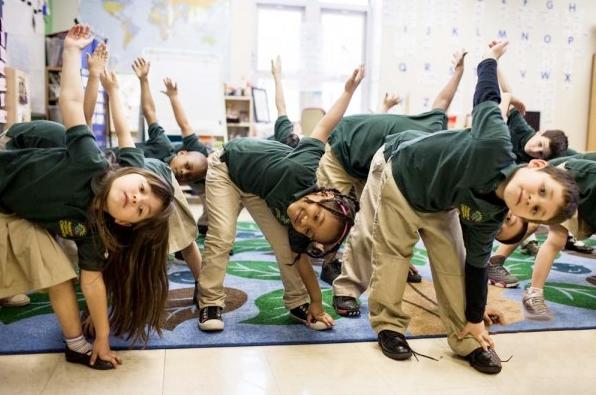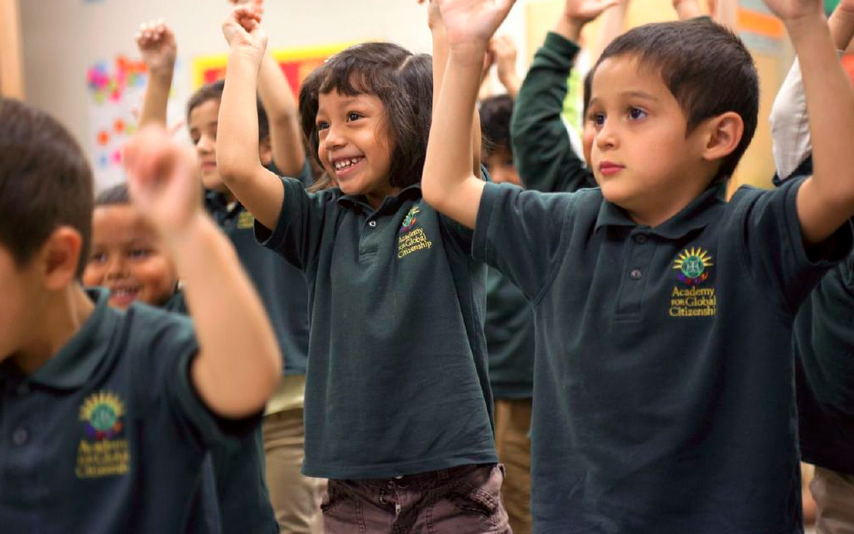Yoga in the classroom helps to keep students calm and focused.
By Linda Mura O’Toole
In 2004 Carla Tantillo was teaching English at a grade school in South Lawndale on Chicago’s West Side. One morning before the first bell rang, shots rang out in a fight between two gangs. One of the teenage boys who was shot attended Tantillo’s school. Many of her students knew him and were understandably distressed. Unable t calm them, Tantillo quickly recognized that her students had no tools to manage their stress or even anger.
Having recently completed a yoga teacher training program, Tantillo decided to use breathing exercises and yoga poses to help her students relax and become more focused and less agitated. It worked. “We started with simple breathing exercises and a few basic poses like Tree and Child’s pose,” she says.
Tragically, during the past 10 years, gang violence has escalated in Chicago. While no one would suggest yoga is the answer to eradicating gun violence and gangs, many educators believe it can help children students deal with anxiety and stress at school.
Since that incident, Tantillo’s own journey has taken a few twists and turns. She left teaching the following year to pursue graduate studies in education, but it wasn’t the right fit. Although Tantillo came from a long line of educators and shared her family’s passion for teaching, something was missing.
One afternoon over lunch, Tantillo’s mother, a retired school principal, showed her an article about a school offering yoga and suggested she teach yoga in school. “It was one of those ‘Aha!’ moments,” Tantillo says. “I had a regular yoga practice, had completed my 200-hour teacher training program and didn’t want to leave the classroom.”
Tantillo packed up her apartment, put her belongings in storage and moved back in with her parents. After a sabbatical in Italy, where she wrote the yoga curriculum, she signed up eight schools by the 2006-2007 school year. In 2008, she founded Mindful Practices, based in Oak Park, which creates wellness programs for schools.
Tantillo believes yoga is perfect for kids because it is non-competitive, non-threatening and adaptable to all skill levels. For example, Tantillo worked with the Academy for Global Citizenship (AGC), a Chicago charter school with 350 kindergarten through sixth grade students, to develop its wellness program for all grades. The Southwest Side school serves the “whole” child, with an emphasis on fostering international understanding and promoting environmental awareness. Each day this learning laboratory begins with an organic breakfast followed by a school-wide, 15- to 20-minute yoga session.
The yoga practices help “meet students’ specific needs, whether it is to help calm, energize or refocus,” says AGC founder Sarah Elizabeth Ippel. Each classroom features a Yoga Corner, where students can practice individually. For example, if a student has too much energy and can’t sit still, he might visit the Yoga Corner and practice Child’s pose. Or if a student is tired and needs more energy, she could practice Warrior I pose.
“The wellness program is adaptable based on a student’s grade level or individual needs,” Ippel said. “In kindergarten, yoga poses might be introduced or taught using a story. A teacher might say, ‘Walk thought the forest and see the trees,’ at which point the students would stand in Tree pose.”
In first grade, students learn to become yoga leaders and work with the teacher to lead a class. In second grade, a student might be able to create his or her own Vinyasa Flow class using yoga pose flash cards designed by Mindful Practices.
Ippel is convinced of the yoga program’s benefits to students. “It’s a smart investment that goes a long way,” she says. “The world would be a better place if we could implement a yoga program in every school.”
Other schools are following suit. Founded in 2004 and located on the Southwest Side, the Namaste Charter School takes a holistic approach to education with an emphasis on nutrition, health and wellness. Each student begins the day with a nutritious breakfast and Morning Movement, including yoga and breathing exercises.
“We know if children are healthy and active, they will perform better in the classroom,” said Allison Lipsman, director of development for the Namaste Charter School. “Movement helps students refocus and re-energize,” Lipsman continues. “Likewise Tree and Child’s pose makes children more relaxed, calm and able to do their work.”
Although it is difficult to measure the impact of yoga in the classroom, nearly 98 percent of Namaste students met or exceeded state standards—20 points higher than that of their counterparts across Chicago Public Schools. A number of recent studies, including reports from Harvard Medical School, revealed that yoga could reduce stress and enhance concentration in children.
According to the International Association of School Yoga and Mindfulness, more than 1,000 schools in the U.S. offer a yoga and mindfulness program with more than 25,000 professionals trained to teach yoga or mindfulness in schools. However, some are skeptical about yoga’s teachings and are demanding that school administrators roll up the yoga mats.
In April 2013, attorney Dean Broyles from the National Center for Law and Policy, a conservative Christian legal group, filed a lawsuit on behalf of parents in the Encinitas Union School District (EUSD) in California. The suit alleges that EUSD incorporated Ashtanga yoga, which “unlawfully promotes religious beliefs” and violates the U.S. Constitution.
Three months later, Judge John S. Meyer ruled that the instruction method was not religious and agreed with the school assertions that yoga classes are strictly for health and wellness purposes and had been stripped of “cultural components” that some claim were religious in context.
In a July 2013 article from the Union-Tribune San Diego, Judge Meyer added that the district curriculum and lesson plans show no promotion of religion or spirituality. “The physical education, health and wellness class is no different,” Meyer said, “except that the physical aspect instead of kickball or something else is yoga.” Broyles and the parents he represented are planning to appeal the decision.
The Encinitas yoga program was started with a $533,000 grant from the K.P. Jois Foundation. The group promotes Ashtanga and is also funding a study of yoga classes in hopes of showing its benefits to students.
“My hope is that all schools honor and recognize the connection between students’ social and emotional needs, the physical body and student achievement. For me, yoga is a vehicle to empower students, parents and teachers to meet those needs, but it is not the only one,” said Tantillo. “If we can empower students, teachers and parents with tools to cultivate self-awareness and self-regulation, we have prioritized life-long learning…educating the whole child and honoring the importance of the community in which that child is housed.”
(Note: In late September, the first-ever National Kids Yoga Conference was held in Washington, D.C. A primary goal is to standardize and secularize the practice of yoga, according to the conference sponsors.)
Linda Mura O’Toole is a registered yoga teacher and received her certificate of training from House of Shanti. She currently teaches at Reach Yoga in Glencoe.

























No Responses to “Reading, Writing and Warrior I”